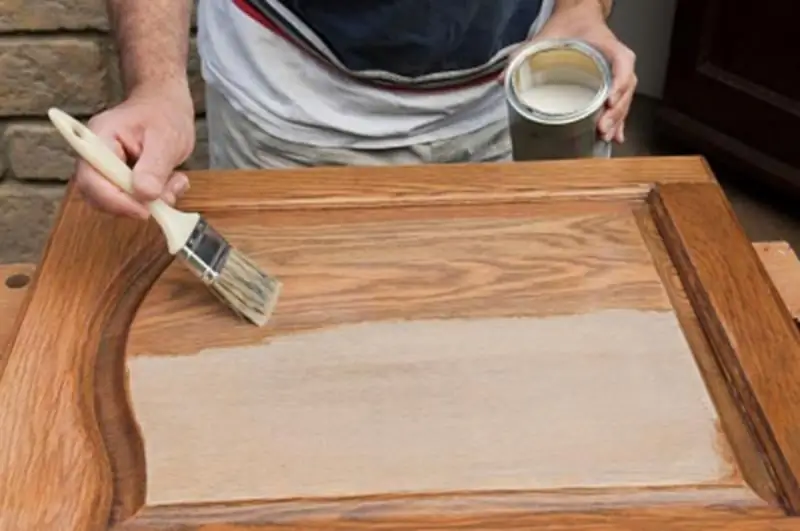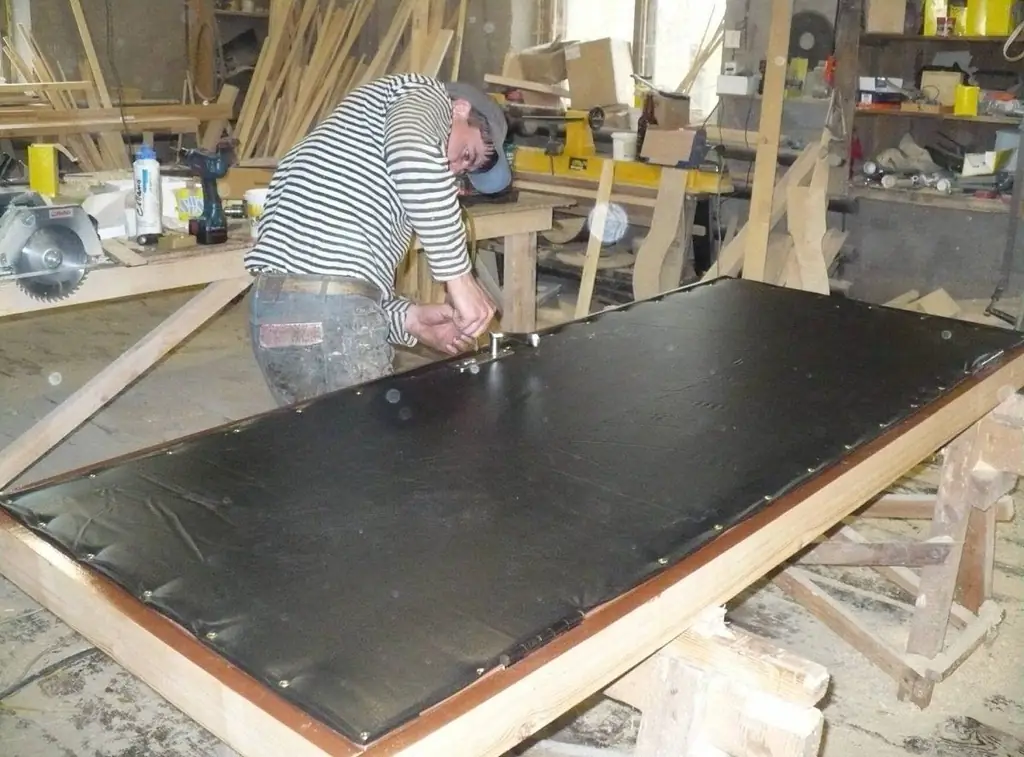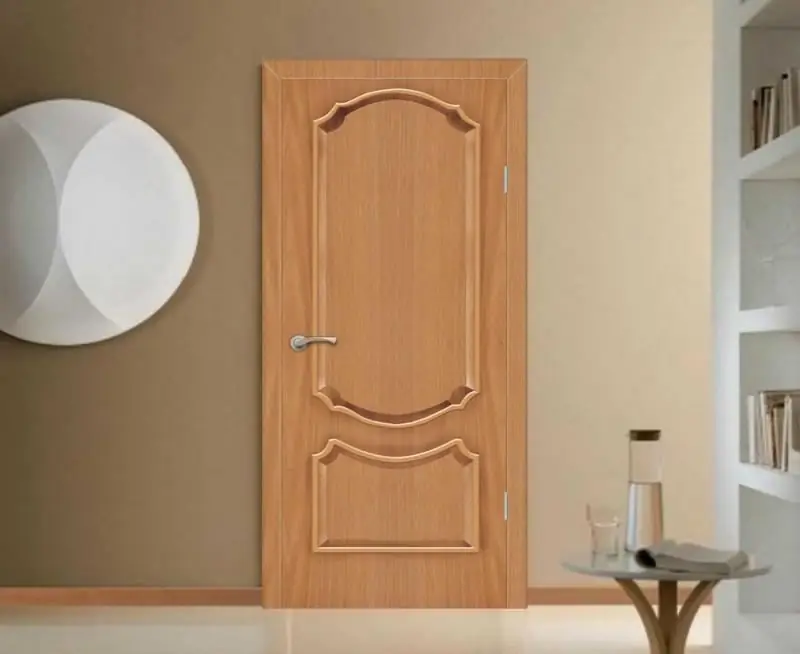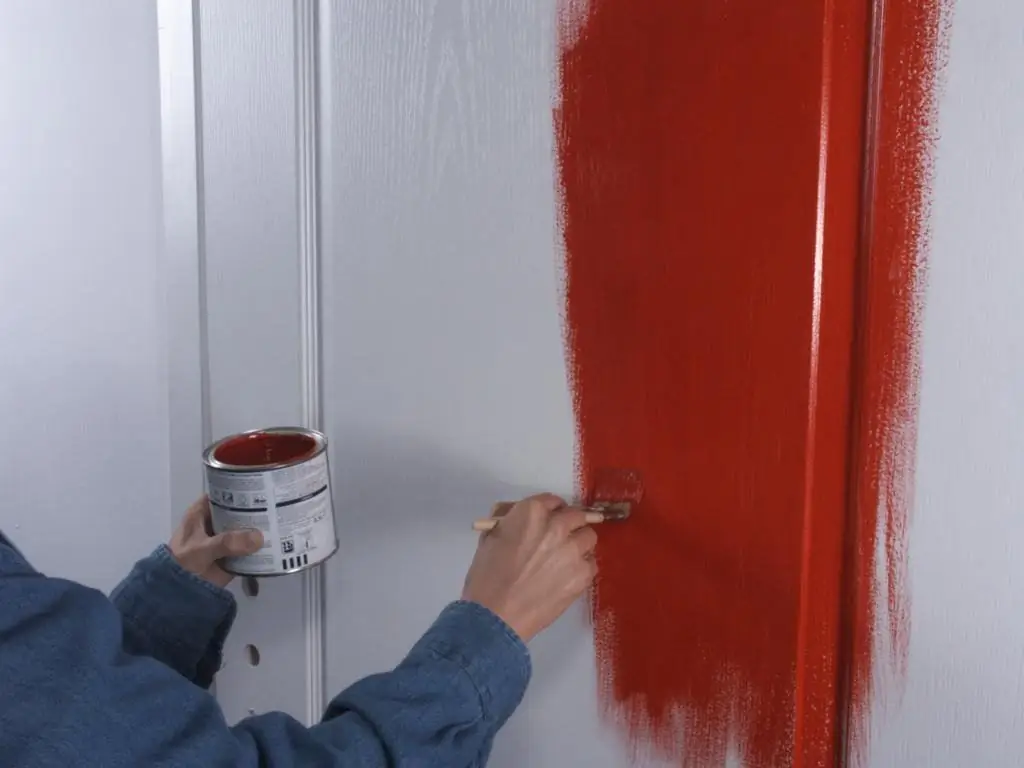Table of contents:
- Do-it-yourself door painting
- Types of paints for doors
- Choosing a painting tool
- Door painting technology
- Features of door varnish coating

Video: Do-it-yourself Painting Of Doors: Features For Different Types Of Canvas, The Choice Of Paint And Varnish, Stages Of Work

2024 Author: Bailey Albertson | [email protected]. Last modified: 2023-12-17 12:53
Do-it-yourself door painting

Doors are the same layout element as walls, ceiling or floor. During operation, there is a gradual wear of the outer surfaces of the door frame and door leaf. To extend the service life and restore damaged areas, it is recommended to paint the doors every 5 - 7 years. Why is it useful to familiarize yourself with the principles of applying a protective coating to various types of products.
Content
- 1 Types of paints for doors
- 2 Choosing a tool for painting
-
3 Door painting technology
- 3.1 Rules for painting a wooden door
- 3.2 Rules for painting doors made of fiberboard
-
3.3 Rules for painting a metal door
3.3.1 Video: how to paint the doors correctly
-
4 Features of coating the door with varnish
4.1 Video: how to varnish the door
Types of paints for doors
Do not be afraid of the huge variety of coloring enamels. The packaging always contains detailed instructions for the use of a particular coating. And the first thing you need to pay attention to is what material the paint is intended for. Inappropriate use leads to rapid wear of the door coating - loss of gloss, peeling and cracking.
There are four types of coatings for wood products:
-
Alkyd enamels and varnishes delight with the price and wide color palette. The polymerization process takes place quickly - after 1.5 - 2 hours the surface to be painted sets and is resistant to the influence of dust, moisture and deformation. Complete drying occurs within 24 hours. You can use a brush or roller to treat the wood surface. The disadvantages include:
- fragility, after 1–2 years the surface loses its shine, burns out, cracks with temperature drops;
- the presence of toxic substances that are not recommended for use inside the dwelling. The door exudes a specific smell for a long time;
-
exposure to temperature extremes. Alkyd resins, on the basis of which enamel is made, tolerate high humidity well, but a change in temperature conditions leads to cracking of the smooth surface. The optimum range is -30 °… + 5 ° C.

Alkyd enamel Alkyd enamel has a short service life
-
Acrylic enamels and varnishes. They are made on a water basis. The disadvantages of alkyd paint and nitro enamels are leveled out due to the composition selected from water-soluble colors. The only drawback of acrylic material is the high price. The undoubted advantages are:
- lack of harmful substances and volatile solvents in the composition;
- wide range of colors;
- the formation of an elastic elastic film upon drying, on which cracks do not form;
-
color fastness to ultraviolet radiation.

Acrylic paint Water-based acrylic enamels come in a huge variety of colors and shades
-
Nitro paints and varnishes. They are used outside residential premises, most often in industrial facilities. This is due to the fact that the solvent on the basis of which the paint is made is toxic and flammable. When carrying out work, it is necessary to ensure good ventilation of the room. Nevertheless, this type of coating is in demand because it is the most durable and resistant to adverse factors. Drying takes place within 30-60 minutes (depending on the layer thickness). The polymer film covering the wood lasts up to 5 years without compromising its appearance.

Nitro paint Nitro paint can only be removed with a special solvent
-
Oil paints. They are absorbed into the wood by 0.3-0.5 mm (depending on the type of wood). As a result, the outer surface layer becomes water-repellent and durable. However, today this material is not so popular, and there are good reasons for this:
- long drying time - complete hardening occurs no earlier than 24 hours (depending on the humidity of the environment);
- low compatibility with other types of paints. If it is necessary to re-coat the doors, the previous layer must be completely removed (including sanding);
- high price;
-
sensitivity to mechanical damage.

Oil paint for doors Oil paint dries for a long time
All described types of paints are used for metal doors, but there are also specially designed for steel surfaces. These include:
-
Hammer paint. The coating combines good decorative properties with increased durability. After drying, a pattern appears on the doors that imitates the blow of a blacksmith press. Operational advantage - the paint can be applied to a rusty surface after degreasing and removing fine debris and dust. There are other benefits too:
- high strength of the coating, which can withstand even blows by metal objects;
- long service life, it exceeds 10-12 years;
-
protection of metal from corrosion, temperature and humidity changes.

Hammer paint coating Hammer paint protects metal from corrosion, mechanical stress and temperature extremes
- Powder paint. Industrial version of door painting. It is impossible to apply the coating at home, since this requires special equipment - a muffle furnace, in which the powder is melted and baked. The result is an extremely durable coating that lasts for several decades.
-
Blacksmith paint. An expensive coating that can turn an ordinary door into a work of art. Various colors and shades allow you to imitate gold leaf or silver that has tarnished over time. In such cases, specialists-artists are most often invited, who are guaranteed to give the coating the necessary visual effect. The performance properties are as good as hammer paint. Long service life and resistance to adverse factors offset the financial costs.

Blacksmith door paint Blacksmith paint imitates a coating of precious metals on the door surface
Choosing a painting tool
In the factory, sophisticated automatic equipment is used to cover doors. The top layer is not only painted, but also polished. A hand tool is used at home. All brushes and rollers are different and serve different purposes. For example, a brush with a long bristle paints hard-to-reach indentations better, but sprinkles paint on a flat surface, and a roller with a short "hair" saves varnish by stretching it more evenly over the entire surface. For painting you will need:
-
brush 40–50 mm wide with a pile length of 30–40 cm;

Paint brushes Paint brushes differ from each other in width and length of the pile
- fur roller 8–10 cm wide and 2 cm in diameter;
- sandpaper on a flat bar or grinder (the grain size of the emery is selected depending on the thickness of the layer to be removed);
- rags to eliminate unwanted drips (soft, one-color cotton fabric);
-
a container for diluting paint (a bowl or a factory plastic tray);

Paint tray The ink dilution tray is matched to the width of the roller
- solvent for degreasing the surface (any composition is suitable, except for gasoline);
-
paper tape.

Paper tape Paper tape will protect surfaces from paint ingress
In addition, it is necessary to provide for the presence of a locksmith tool necessary to remove the door leaf from the hinges:
-
screwdrivers or screwdrivers;

Screwdriver The electric screwdriver significantly speeds up the process of installing and removing the door leaf
- mounts;
- pliers;
-
painting knife;

Painting knife The painting knife allows you to quickly remove small burrs from the painted surface
- goats for installing the curtain in a horizontal position.
The place for the procedure is chosen spacious and dry, with good ventilation. When using paint with a strong odor (alkyd or nitro enamel), it is recommended to use a respirator to protect the respiratory organs. If the coating is carried out using a compressor or a spray gun, it is worth taking care of protecting nearby walls and furniture from sprayed paint. With this, plastic wrap will do well, with which all the objects in the room are carefully covered.
Door painting technology
Door block painting consists of two stages. Coating on:
- door frame;
- canvas.
When carrying out restoration work, the door frame is not dismantled, but it is advisable to remove the sash from the hinges. This is necessary so that the paint lies evenly and does not form drips.
The order of work might look like this:
-
Dismantling of doors. To remove the blade, you need to disconnect the bearing hinges with a screwdriver or screwdriver. It is necessary to unscrew all 4 screws on each of the hinges and carefully remove the blade from the frame. Then put on a stable support (two or three chairs, stools or bedside tables). Additionally, you will need to remove all fittings.

Worker dismantles the lock In addition to removing the canvas from the hinges, it is necessary to dismantle all the fittings from the sash
-
Preparatory work. At this stage, you need to conduct a thorough inspection of the entire surface of the door. If the old paint peels off, clean it with sandpaper, if there are chips and scratches, putty with a special putty on wood. Metal doors are cleaned of rust, if necessary, they are puttyed and degreased (as well as wooden ones). A small piece of cloth is moistened in a solvent and the entire surface is wiped for painting. Allow time between the puttying and degreasing operations so that the putty is completely dry. Sometimes you have to sand the surface again to level the putty areas.

Woman next to the door leaf Before painting, the door leaf must be cleaned, putty and degreased
-
Painting. It is important to remember here that it is better to select the consistency of the material in such a way that it does not spread, but also does not become too thick. It is recommended to adjust this parameter with a solvent, which must be added to the paint can and stirred thoroughly until smooth. The frame is painted over with a brush or roller. First, they go through all the difficult places - grooves, abutment to the wall, joints, etc., then cover the rest of the surface. To prevent paint from staining the walls, they are glued with paper tape. Experienced painters always move from the top, starting from the crossbar and ending with the bottom of the side posts. The canvas is coated with paint in random order, but so that the coating is uniform, without voids and "bald spots". As a rule, first work with one side, and when it dries, the door is turned over and worked with the other. It is important to wait until it is completely dry - polymerization is only considered complete when the top layer has completely hardened. The drying time can be found on the packaging.

Woman painting the door The canvas is placed at a convenient height for work and in a well-lit place
- Door installation. After they are painted and dry, they are mounted in their original place. To do this, the canvas is put in a working position and fixed on the hinges.
When choosing a painting method and a tool, it should be borne in mind that the brush, no matter how thin its pile is, always leaves small stripes on the surface, the roller provides a more uniform coating, and the spray gun, although it paints well, is expensive - the kit includes a spray and a compressor, which is somewhat wasteful for home repairs.
From personal experience, I can advise you to use an ordinary household vacuum cleaner as a compressor for a spray bottle. Soviet vacuum cleaners of the "Raketa" type were equipped with a plastic spray, which is very convenient to tint small objects, including doors. The only thing to consider when doing this is that nitro enamel can corrode plastic. There will be no problems with the rest of the paints.
In general, the coating technology is identical for any materials, but there are some nuances depending on the type of door. This mainly concerns the density of the paint.
Rules for painting a wooden door
Wood partially absorbs liquid, therefore, in order for the paint to adhere well to the surface of such a door, it is recommended to apply the first layer (primer) with a more liquid material. In terms of density, such a composition is close to ordinary water, it is obtained by diluting the paint with a solvent (acrylic paint is mixed with pure water).
The first layer of wood coating is made very thin. The second, and, if necessary, the third, is applied with the composition provided by the manufacturer.
Rules for painting doors made of fiberboard
Chipboards absorb moisture even better at absorbing moisture than wood. Therefore, in order to avoid swelling of the fiberboard door surface, paint with a thick material. The first layer is applied very thin, so that it only absorbs and dries immediately. Subsequent can be applied without paint thinning.
Rules for painting a metal door
The metal is resistant to moisture, but for better adhesion, it is advisable to start painting with a liquid composition, which, due to its fluidity, will fill all irregularities and smooth out roughnesses. It is important to let the first coat dry well. It depends on this whether the paint will crack and peel in the future. For the second and third layers, a material of normal consistency is used, while the paint must be carefully rolled out with a roller.
Video: how to paint the doors correctly
Features of door varnish coating
Varnish differs from paint only in that it is transparent, so surface preparation must be more thorough. The fact is that the paint hides defects, and the varnish emphasizes them. In addition, in the first case, you can walk with a sandpaper, and then paint over again. With varnish, such an edit will not work. The sanded area, even if covered with a new layer of varnish, will stand out and look matte.

When using nitrolac, it is necessary to protect the respiratory organs with a respirator
Sometimes, especially when using a textured varnish, it is more advisable to apply the material with a swab (but not with a foam rubber, if the varnish is not water-based). This type of coating adds a kind of visual effects that designers sometimes use. In this case, heavy, thick mixtures are used, which quickly freeze from contact with air. As a tampon, you can use rubber porous materials that are resistant to solvents.
When starting to restore a door block, do not forget about personal safety equipment. A respirator will protect the mucous membrane from irritation, rubber gloves will protect hands from sticky paint and toxic solvents, open windows and good ventilation will prevent the accumulation of harmful fumes.
Video: how to varnish the door
Painting a door is an inexpensive and affordable way to update a door, not only in design, but also in performance. The correct choice of material, tool and adherence to technology will allow you to do this work with your own hands with high quality.
Recommended:
Sheathing (upholstery) Of Doors: The Choice Of Material For Finishing, Tools And Stages Of Work

In what cases is door trim necessary. Materials used to cover doors. A necessary tool. The procedure for self-upholstery doors
MDF Doors: Entrance And Interior Doors, Their Varieties With A Description And Characteristics, Advantages And Disadvantages, As Well As Installation And Operation Features

Doors from MDF: features, characteristics, varieties. Making and installing MDF doors with your own hands. Door restoration. Reviews, photos, videos
Painting Wooden Doors: Which Paint Is Better To Choose, As Well As How To Properly Varnish The Surface

How to prepare a door for painting and which product to choose. Tools and materials for painting wooden doors. How to paint yourself
How To Paint Interior Doors, What Paint To Choose For Various Surfaces

How to choose paint for interior doors from different materials. Preparation and processing of the door. Removing the old coating
What Paint Is Best For The Ceiling In The Kitchen: Types, Methods Of Painting, Recommendations, Photos

What to consider when painting the ceiling in the kitchen. Choice of paint and color. Tools, preparation and work stages. Kitchen design with a painted ceiling
